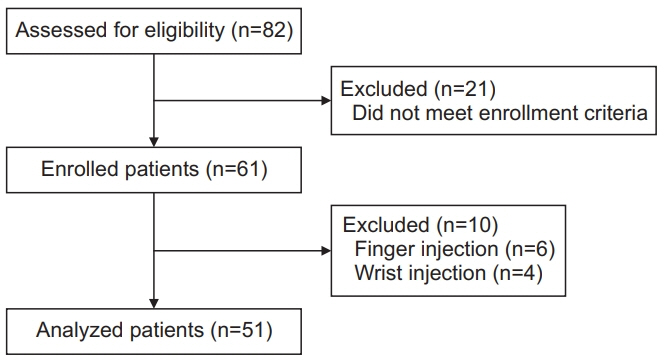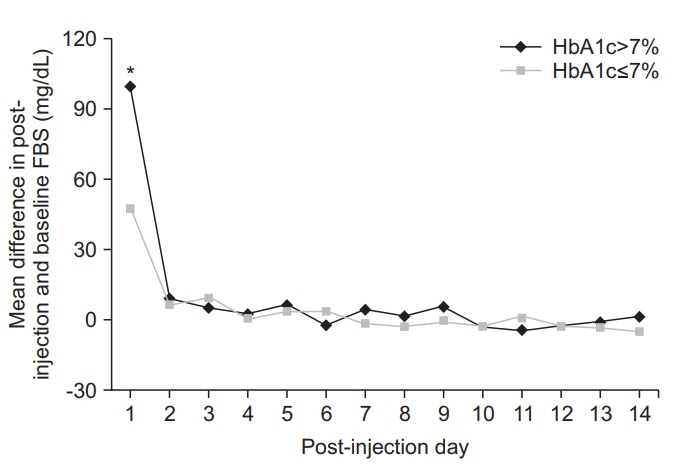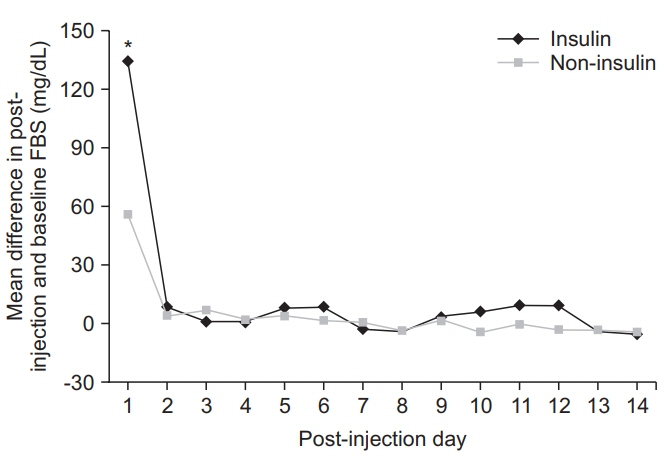Ann Rehabil Med.
2020 Apr;44(2):117-124. 10.5535/arm.2020.44.2.117.
Changes in Blood Glucose Level After Steroid Injection for Musculoskeletal Pain in Patients With Diabetes
- Affiliations
-
- 1Department of Rehabilitation Medicine, Gwangju Veterans Hospital, Gwangju, Korea
- KMID: 2501055
- DOI: http://doi.org/10.5535/arm.2020.44.2.117
Abstract
Objective
To investigate changes in blood glucose level after steroid injection in patients with type 2 diabetes mellitus (DM) and factors affecting those changes.
Methods
We retrospectively studied 51 patients with type 2 DM who underwent steroid injection for shoulder and back pain. Mean fasting blood sugar (FBS) levels for 7 days before steroid injection was used as the baseline blood glucose level, which was compared with FBS levels for 14 days after steroid injection. We compared the differences in blood glucose changes between HbA1c >7% and HbA1c ≤7% groups and those between insulin and non-insulin treated groups. Demographic data, injection site, and steroid dose were analyzed.
Results
Compared to baseline, blood glucose significantly (p=0.012) elevated 1 day after steroid injection but not 2 days after injection. In the HbA1c >7% and insulin groups, blood glucose was significantly increased 1 day after injection compared to that in the HbA1c ≤7% (p=0.011) and non-insulin (p=0.024) groups, respectively. Higher HbA1c level before injection was significantly (p=0.003) associated with the degree of blood glucose increase 1 day after injection. No significant differences were noted in the degree of blood glucose increase according to injection site or steroid dose.
Conclusion
Higher HbA1c level was associated with greater elevation in blood glucose 1 day after steroid injection. Careful monitoring of blood glucose is required on the first day after steroid injection in patients with poorly controlled DM.
Keyword
Figure
Reference
-
1. Arslan S, Celiker R. Comparison of the efficacy of local corticosteroid injection and physical therapy for the treatment of adhesive capsulitis. Rheumatol Int. 2001; 21:20–3.2. Lorbach O, Kieb M, Scherf C, Seil R, Kohn D, Pape D. Good results after fluoroscopic-guided intra-articular injections in the treatment of adhesive capsulitis of the shoulder. Knee Surg Sports Traumatol Arthrosc. 2010; 18:1435–41.
Article3. Botwin KP, Gruber RD, Bouchlas CG, Torres-Ramos FM, Sanelli JT, Freeman ED, et al. Fluoroscopically guided lumbar transformational epidural steroid injections in degenerative lumbar stenosis: an outcome study. Am J Phys Med Rehabil. 2002; 81:898–905.4. Ranalletta M, Rossi LA, Bongiovanni SL, Tanoira I, Elizondo CM, Maignon GD. Corticosteroid injections accelerate pain relief and recovery of function compared with oral NSAIDs in patients with adhesive capsulitis: a randomized controlled trial. Am J Sports Med. 2016; 44:474–81.5. Buttermann GR. The effect of spinal steroid injections for degenerative disc disease. Spine J. 2004; 4:495–505.
Article6. Zufferey P, Revaz S, Degailler X, Balague F, So A. A controlled trial of the benefits of ultrasound-guided steroid injection for shoulder pain. Joint Bone Spine. 2012; 79:166–9.
Article7. Chen MJ, Lew HL, Hsu TC, Tsai WC, Lin WC, Tang SF, et al. Ultrasound-guided shoulder injections in the treatment of subacromial bursitis. Am J Phys Med Rehabil. 2006; 85:31–5.
Article8. Hart L. Corticosteroid and other injections in the management of tendinopathies: a review. Clin J Sport Med. 2011; 21:540–1.9. Habib GS, Miari W. The effect of intra-articular triamcinolone preparations on blood glucose levels in diabetic patients: a controlled study. J Clin Rheumatol. 2011; 17:302–5.10. Stepan JG, London DA, Boyer MI, Calfee RP. Blood glucose levels in diabetic patients following corticosteroid injections into the hand and wrist. J Hand Surg Am. 2014; 39:706–12.
Article11. Even JL, Crosby CG, Song Y, McGirt MJ, Devin CJ. Effects of epidural steroid injections on blood glucose levels in patients with diabetes mellitus. Spine (Phila Pa 1976). 2012; 37:E46–50.
Article12. Botwin KP, Gruber RD, Bouchlas CG, Torres-Ramos FM, Freeman TL, Slaten WK. Complications of fluoroscopically guided transforaminal lumbar epidural injections. Arch Phys Med Rehabil. 2000; 81:1045–50.
Article13. Donatti TL, Koch VH, Takayama L, Pereira RM. Effects of glucocorticoids on growth and bone mineralization. J Pediatr (Rio J). 2011; 87:4–12.
Article14. Duclos M, Guinot M, Colsy M, Merle F, Baudot C, Corcuff JB, et al. High risk of adrenal insufficiency after a single articular steroid injection in athletes. Med Sci Sports Exerc. 2007; 39:1036–43.
Article15. Iwamoto T, Kagawa Y, Naito Y, Kuzuhara S, Kojima M. Steroid-induced diabetes mellitus and related risk factors in patients with neurologic diseases. Pharmacotherapy. 2004; 24:508–14.
Article16. Lotan R, Oron A, Anekstein Y, Shalmon E, Mirovsky Y. Lumbar stenosis and systemic diseases: is there any relevance? J Spinal Disord Tech. 2008; 21:247–51.17. Jeffcoate WJ, Game F, Cavanagh PR. The role of proinflammatory cytokines in the cause of neuropathic osteoarthropathy (acute Charcot foot) in diabetes. Lancet. 2005; 366:2058–61.
Article18. Xu G, Pierson CR, Murakawa Y, Sima AA. Altered tubulin and neurofilament expression and impaired axonal growth in diabetic nerve regeneration. J Neuropathol Exp Neurol. 2002; 61:164–75.
Article19. Kim N, Schroeder J, Hoffler CE, Matzon JL, Lutsky KF, Beredjiklian PK. Elevated hemoglobin A1C levels correlate with blood glucose elevation in diabetic patients following local corticosteroid injection in the hand: a prospective study. Plast Reconstr Surg. 2015; 136:474e–9e.20. Wang AA, Hutchinson DT. The effect of corticosteroid injection for trigger finger on blood glucose level in diabetic patients. J Hand Surg Am. 2006; 31:979–81.
Article21. Yoon JS, Kim SJ, Park EM. The change of blood sugar level after steroid injection in shoulder pain with diabetes mellitus. J Korean Acad Rehabil Med. 2003; 27:557–60.22. Aleem AW, Syed UA, Nicholson T, Getz CL, Namdari S, Beredjiklian PK, et al. Blood glucose levels in diabetic patients following corticosteroid injections into the subacromial space of the shoulder. Arch Bone Jt Surg. 2017; 5:315–21.23. Habib G, Safia A. The effect of intra-articular injection of betamethasone acetate/betamethasone sodium phosphate on blood glucose levels in controlled diabetic patients with symptomatic osteoarthritis of the knee. Clin Rheumatol. 2009; 28:85–7.
Article24. Kallock E, Neher JO, Safranek S. Clinical inquiries. Do intra-articular steroid injections affect glycemic control in patients with diabetes? J Fam Pract. 2010; 59:709–10.25. Moon HJ, Choi KH, Lee SI, Lee OJ, Shin JW, Kim TW. Changes in blood glucose and cortisol levels after epidural or shoulder intra-articular glucocorticoid injections in diabetic or nondiabetic patients. Am J Phys Med Rehabil. 2014; 93:372–8.
Article26. Kim WH, Sim WS, Shin BS, Lee CJ, Jin HS, Lee JY, et al. Effects of two different doses of epidural steroid on blood glucose levels and pain control in patients with diabetes mellitus. Pain Physician. 2013; 16:557–68.27. Dahl J, Hammert WC. Overview of injectable corticosteroids. J Hand Surg Am. 2012; 37:1715–7.
Article28. MacMahon PJ, Eustace SJ, Kavanagh EC. Injectable corticosteroid and local anesthetic preparations: a review for radiologists. Radiology. 2009; 252:647–61.
Article29. Catalano LW 3rd, Glickel SZ, Barron OA, Harrison R, Marshall A, Purcelli-Lafer M. Effect of local corticosteroid injection of the hand and wrist on blood glucose in patients with diabetes mellitus. Orthopedics. 2012; 35:e1754–8.
Article30. Stratton IM, Adler AI, Neil HA, Matthews DR, Manley SE, Cull CA, et al. Association of glycaemia with macrovascular and microvascular complications of type 2 diabetes (UKPDS 35): prospective observational study. BMJ. 2000; 321:405–12.
Article31. Ahmed N. Advanced glycation endproducts: role in pathology of diabetic complications. Diabetes Res Clin Pract. 2005; 67:3–21.32. Morris D. Steroid-induced diabetes and hyperglycaemia. Part 1: Mechanisms and risks. Diabetes Prim Care. 2018; 20:151–3.33. Younes M, Neffati F, Touzi M, Hassen-Zrour S, Fendri Y, Bejia I, et al. Systemic effects of epidural and intraarticular glucocorticoid injections in diabetic and non-diabetic patients. Joint Bone Spine. 2007; 74:472–6.
Article34. Choudhry MN, Malik RA, Charalambous CP. Blood glucose levels following intra-articular steroid injections in patients with diabetes: a systematic review. JBJS Rev. 2016; 4:01874474-201603000-00002.
Article
- Full Text Links
- Actions
-
Cited
- CITED
-
- Close
- Share
- Similar articles
-
- The Change of Blood Sugar Level after Steroid Injection in Shoulder Pain with Diabetes Mellitus
- The Change of Blood Glucose and Cortisol Levels after Three Consecutive Epidural Steroid Injections
- Risk analysis of musculoskeletal pain intervention using corticosteroid during COVID-19 pandemic: a cohort study
- Treatment of Post-herpetic Neuralgia in the Patient Who had Steoid-induced Hyperglycemia
- Effects of Steroid Administration on the Blood Glucose Level during Spine Surgery in Patients with Metabolic Syndrome





